We were dry and now it has turned off wet again with several rainy days in the forecast. I still have not been able to find a population of foliage feeders in a peanut field in the county… fingers crossed, see Dr. Abneys update on insects in peanut further in this newsletter. I was starting to see fields with several hits of white mold last week, although the cool weather this week will slow white mold down some to an extent, but do remember we can utilize rain in dryland fields to move fungicide products to the crown of the plant to better combat white mold. The Cotton Jassid has been a hot topic across south Georgia this week especially in Appling County, read further in this email for more information of what we currently know about the Cotton Jassid.
Topics in this Newsletter:
- Cotton Jassid / Two Spotted Cotton Leafhopper in Georgia (Dr. Stormy Sparks, UGA Vegetable Entomologist)
- Cotton Jassid observations in Appling County
- Row Crop Disease Update (Dr. Bob Kemerait, UGA Plant Pathologist)
- CORN UPDATE: Corn Tassel Issues in the MIDWEST (Dr. Nick Shay, UGA Grains Agronomist)
- Post-Harvest (Field Corn) Weed Management Reminders (Dr. Eric Prostko, UGA Weed Specialist)
- What’s Eating the Peanuts…End of July Update (Dr. Mark Abney, UGA Peanut Entomologist)
- Extension Precision Ag and Irrigation Blog Post (Dr. Wes Porter, UGA Precision Ag and Irrigation Specialist)
- August 2025 expected to be wetter than normal, especially in Georgia and South Carolina and surrounding areas (Pam Knox, UGA Climatologist)
- Pesticide Container Recycling & Disposal
- Talkin’ Cotton Podcast (UGA Cotton Team)
- All About the Pod Podcast (UGA Peanut Team)
Cotton Jassid / Two Spotted Cotton Leafhopper in Georgia (Dr. Stormy Sparks, UGA Vegetable Entomologist)
The cotton jassid, Amrasca biguttula, (a.k.a. two spotted cotton leafhopper) has been found in multiple locations in southern Georgia and in South Carolina. This small green leafhopper has a wide host range including cotton and a variety of vegetables. The only damaging populations reported to date have been on okra, with 100+ per leaf. They cause what is generally referred to as hopperburn: yellowing, reddening then browning of leaves followed by wilting and curling. In okra they were found both on the top and bottom of leaves, but primarily along the main leaf veins on the bottom. The cotton jassid adults are readily separated from other small green leafhoppers by distinct dark spots near the wing tips. In vegetables, the greatest potential for damage is reported for okra and eggplant.
Dr. Roberts and I have done some quick bioassays with adults and the results are “inconclusive”. Dr. Roberts got reasonably good mortality with two cotton products we can not use in vegetables. He also got 75-80 % mortality with Assail and Actara. In my bioassay, Venom gave about 60% control and everything else performed poorly (including other neonics, pyrethroids, Group 28s, Lannate, Torac). It is worth noting that this pest is on IRAC’s (Insecticide Resistance Action Committee) radar with reported resistance to OPs, carbamates, pyrethroids and neonicotinoids.




Cotton Jassid observations in Appling County
On July 15, 2025 I was called out to troubleshoot an okra patch in Appling County. The okra patch was found to be infested with a new invasive species called Cotton Jassid, Amrasca biguttula, (a.k.a. two spotted cotton leafhopper). It has since been found in multiple locations in southern Georgia, including several cotton fields. I have been surveying cotton fields for the Cotton Jassid for the past 2 weeks. Last week some fields that I surveyed where found to be infested with Cotton Jassid, spots in these fields had moderate to high damage with low damage occurring across the field. We have had success in cleaning up fields with insecticides, give me a call to discuss treatment options. I will continue to survey fields for this pest in the county, if you believe you have a cotton jassid infestation in your field please give me a call. We still do not have a true threshold for this pest, this is a brand new occurrence and we are learning about this pest as we go. The important thing right now is that we understand what the pest and the damage looks like, once we know those two things we need to keep an eye out for it. If you find a concerning population or damage in a field please give your local county extension agent a call. See the pictures below for aid in ID of the Cotton Jassid and its damage to cotton. In the upper left picture note the 2 black dots on the tips of the wings of the adult Jassid, above the adult jassid is a nypmh. Dr. Phillip Roberts will soon be releasing a report with more information of current observations across south Georgia, stay tuned.
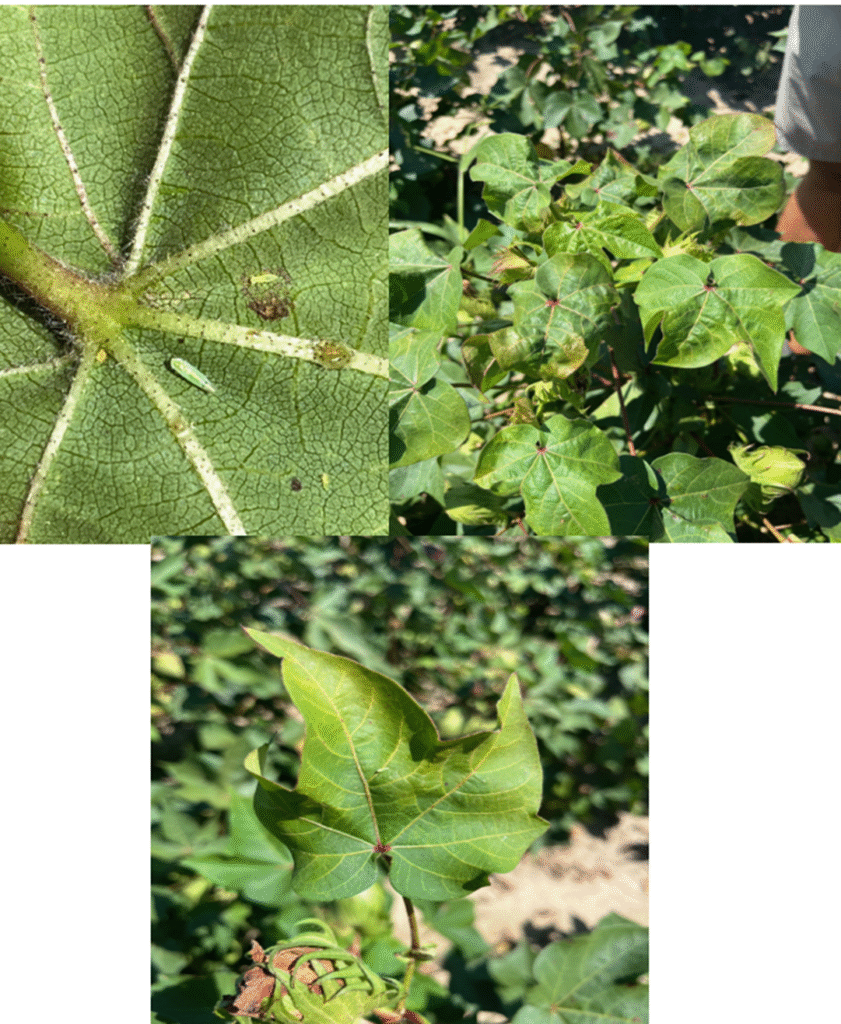
Row Crop Disease Update (Dr. Bob Kemerait, UGA Plant Pathologist)
White Mold in Peanut
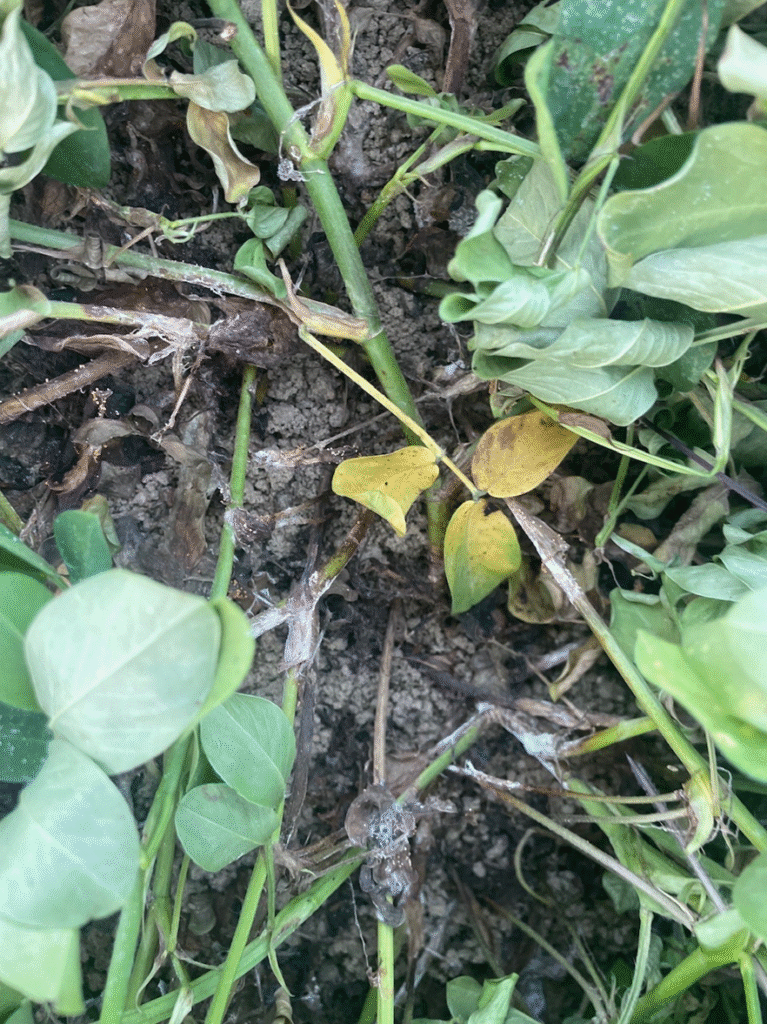
Dr. Culbreath reports finding several “hits” of white mold that are taking individual plants out, but that the disease is contained, for now, to those individual plants. This is because he has deployed a very effective fungicide program. No fungicide program can eliminate white mold from a field, especially from affecting single plants. But an EFFECTIVE fungicide program MUST contain the spread of the disease.
What are the components of an effective white mold program?
1. Timing of the fungicide application to stay ahead of the disease.
2. Taking necessary steps (e.g., irrigation, rainfall, spray-volume, spray at night) to ensure fungicide penetrates the canopy and reaches the crown of the plant.
3. Selection of fungicide.
4. Appropriate rate of fungicide.
These are four of the critical components for successful management of white mold.
Bacterial Blight of Cotton

Consultant Brandon Phillips (also from Mississippi, Dr Hand) sent me this picture of bacterial blight on cotton yesterday. (Note the water-soaked, greasy lesions delimited by leaf veins). Brandon added that while there wasn’t much in the field (yet), conditions there were hot and wet and a storm had passed through. He expects to see more spread next time. This bacterial pathogen, in addition to being seed-borne, is spread easily in wind and blowing rain.
Leaf Scald in Peanut
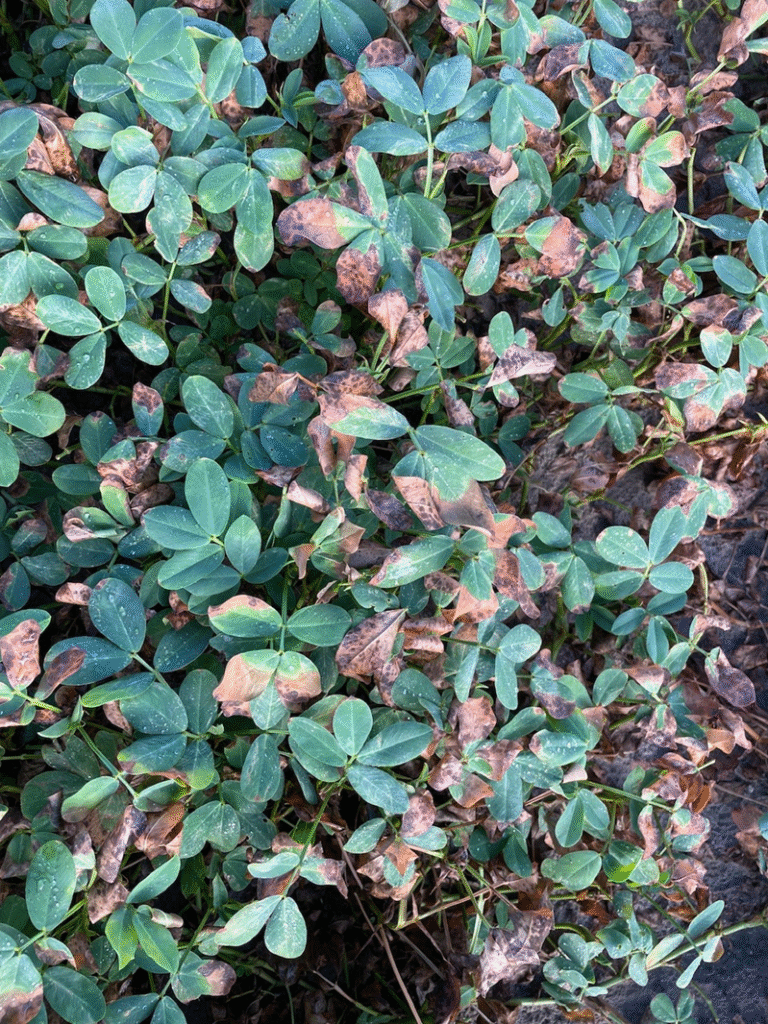
leaf tip necrosis across an entire peanut field. The field is non-irrigated; I suspect this is largely some sort of leaf scald due to our scorching temps of late that has been colonized by secondary saprophytic fungi. Keys to diagnosis? Symptoms are field-wide and largely confined to upper leaves. Patterns tell a story…
Stunted Soybeans ???
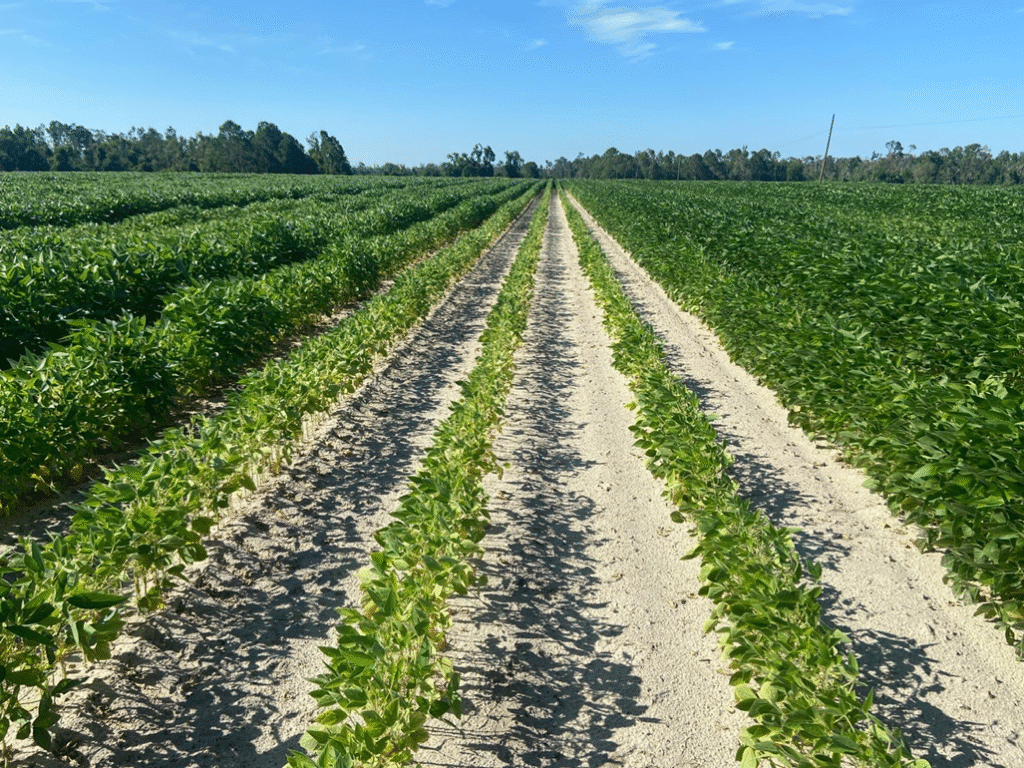
Given a picture of an individual soybean plant I might think charcoal rot or southern blight or nematodes. But when seeing a symptom like this, a row affect,,I have to start wondering “What don’t go out?” “What got misapplied?” Inoculant? Fertilizer? Nematicide? What??? Clearly, there is a pattern, but the pattern can vary and is not always the length of the row. Jennifer is taking soil samples. She will sample from the “bad” and the “good” areas.
Areolate Mildew in Cotton
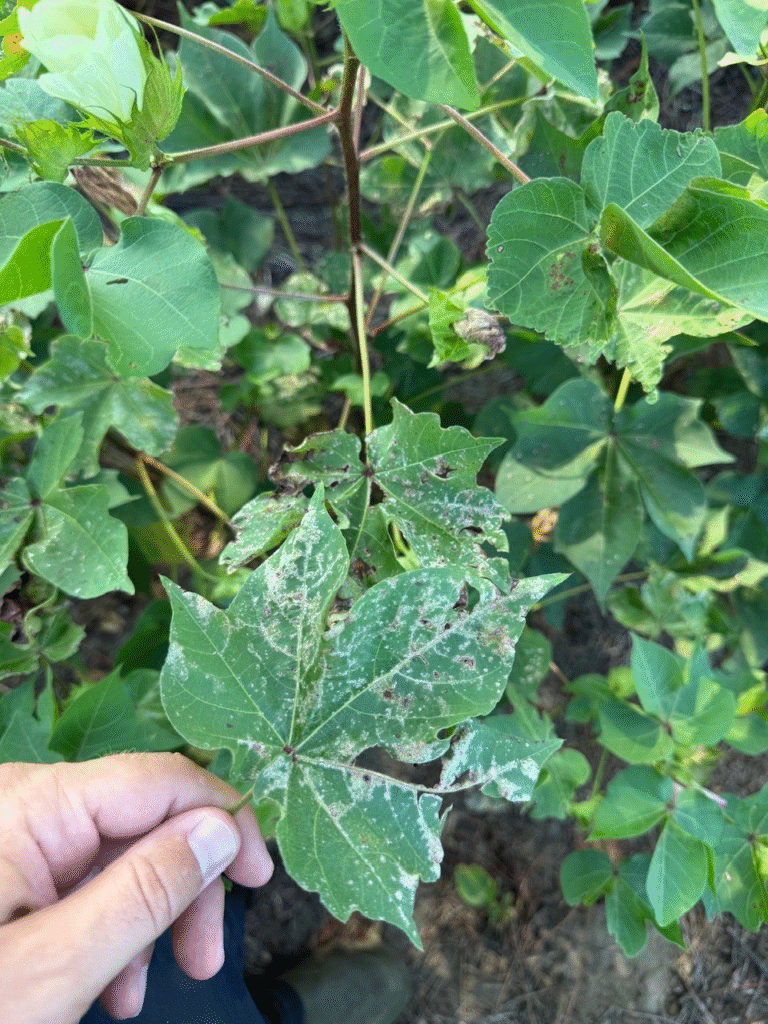
This is almost assuredly areolate mildew and it is right on time.
Growers should scout their cotton fields for areolate mildew and target spot. If left undetected and untreated with a fungicide, bad things can quickly happen in a field of cotton.
CORN UPDATE: Corn Tassel Issues in the MIDWEST (Dr. Nick Shay, UGA Grains Agronomist)
I’m reaching out to highlight a concern raised by colleagues in the Midwest regarding tassel wrapping in corn during the shift from vegetative to reproductive stages. Tassel wrapping occurs when the uppermost leaves, including the flag leaf, remain tightly wrapped around the developing tassel, similar to the tightly wound whorls seen early in the growing season (V3-5) due to extreme temperature swings. According to Dr. Dan Quinn, Extension Corn Agronomist at Purdue University, this phenomenon can delay tassel emergence and pollen shed, potentially affecting pollen availability and silk receptivity (see article below). The causes and yield impacts in states like Indiana, Iowa, Illinois, and Kansas are still unclear. If you observe this issue, please contact me to help document it.
Resource: Wrapped Tassels In Corn: Now What?
Post-Harvest (Field Corn) Weed Management Reminders (Dr. Eric Prostko, UGA Weed Specialist)
Field corn harvest is well underway in much of south Georgia. Please remind your growers that it is a great idea to think about managing weeds such as Palmer amaranth and Benghal dayflower at this time of year. Remember that Palmer amaranth seed is viable within ~2 weeks after pollen shed and Benghal dayflower can go from seed to seed in about 42 days. Thus, there is ample time to produce lots of seed in those harvested corn fields from now until first frost. Check out the UGA Pest Control Handbook (pages 74 and 86) for more specific information.
https://secure.caes.uga.edu/extension/publications/files/pdf/SB%2028-15_3.PDF
a) For growers who will not be planting a small grain this fall, here is one of my favorite post-harvest treatments. The rate for Gramoxone 3SL (paraquat) would be 32 oz/A. Tricor = metribuzin.

b) For those fields that are plagued by Benghal dayflower, splits shots (7-14 days apart) of either Gramoxone or 2,4-D.

What’s Eating the Peanuts…End of July Update (Dr. Mark Abney, UGA Peanut Entomologist)
As harvest begins or approaches in some areas, please monitor crops closely during this extreme heat to ensure a strong finish.
Late July and early August are generally prime time for foliage feeding caterpillars in Georgia peanut fields. Caterpillar pressure has been relatively light so far in 2025, but I have gotten a couple reports of fields at or near threshold over the last few days. A mix of species can and will be found in peanuts this time of year. Velvetbean caterpillar, soybean looper, beet armyworm, and rednecked peanut worm are some of the most common pests you will find in mid to late summer. Proper identification is important to selecting the most efficacious and cost effective insecticide(s) when thresholds are reached.
Scouting and using thresholds to make management decisions will prevent mistakes that cost growers money. Applying insecticides to fields that are not at threshold reduces profit. Likewise, failing to manage an infestation that reaches threshold will result in economic loss.
Lesser cornstalk borer continues to be found in some fields included our UGA Peanut Entomology trials. Continue scouting, and treat this pest if thresholds are reached. Missing an LCB infestation can result in significant losses in yield and increases the risk of aflatoxin.
Folks continue to see potato leaf hoppers in peanut. Though this insect causes characteristic “hopper burn”, its economic impact is generally minimal. Three cornered alfalfa hoppers (TCAH) are related to potato leaf hoppers, but they feed on stems and petioles rather than leaves. Very high numbers of TCAH commonly occur in late August and early September, but insecticide applications are rarely warranted. Available insecticides have limited residual activity, marginal efficacy, and some increase the risk of spider mite infestation later in the season.
Hot, dry conditions favor the development of spider mite infestations. Additionally, the application of broad spectrum insecticides like pyrethroids and acephate can flare mites. If you observe wilting and/or yellowing of plants near field borders, it is worth stopping to check for mites. Finding and treating mite infestations early is critical for successful management. Increasing spray volume when miticides are applied will improve efficacy; I would not spray mites with less than 15 gallons per acre, and I prefer 20 gallons per acre. Even with increased spray volume, two applications are often needed to get mite populations under control.
If you have questions about these topics or any other pest management issue in peanut, please contact your local UGA County Extension Agent. Also, be sure to listen to the All About the Pod podcast for weekly updates from the UGA Peanut Team.
Extension Precision Ag and Irrigation Blog Post (Dr. Wes Porter, UGA Precision Ag and Irrigation Specialist)
Below is the link to this week’s blog post. Thanks to Jason Mallard for putting the post together focusing on current soil moisture conditions and water requirements for cotton and peanut. This is always a moving target and hopefully this post provides everyone with some current considerations. Local knowledge and conditions should be applied.
August 2025 expected to be wetter than normal, especially in Georgia and South Carolina and surrounding areas (Pam Knox, UGA Climatologist)
August 2025 expected to be wetter than normal, especially in Georgia and South Carolina and surrounding areas
The latest monthly outlook for August 2025 shows that the region is slightly like to be warmer than normal this month. The signal for above-normal rainfall is much stronger, with heavier than usual rain most likely in nearly all of Georgia plus SE Alabama and the Florida Panhandle. This is probably in large part due to the heavy rain expected in the next week plus the anticipated ramp-up of the tropics later in the month.


Pesticide Container Recycling & Disposal
I have listed below resources that you can share with producers for this purpose.
- E2A, LLC – AL, GA, SC
229-726-5232
Hal Earnest
hearnest@e2allc.com - USAg Recycling Service – USAg recycles crop production containers, free of charge, through support from the Ag Container Recycling Council. Containers must meet certain requirements for size and type.
USAg Recycling –
Corporate office number for scheduling 800-654-3145
Additional Container Collection & Recycling Resources – The Pesticide Stewardship Alliance (TPSA) has compiled a list of companies that currently collect mini/intermediate bulk containers for recycling. You may search the TPSA database for companies by state.
Talkin’ Cotton Podcast (UGA Cotton Team)
Below is a link to Season 2, Episode 17 of the Talkin’ Cotton Podcast, which is a discussion on the current insect situation in our crop. Reminder that this link takes you straight to buzzsprout, but we also post it on Apple Podcasts, Spotify, Amazon, and other popular podcast platforms. Feel free to distribute far and wide.
https://www.buzzsprout.com/2350262/episodes/17599594
All About the Pod Podcast (UGA Peanut Team)

EPISODE 23, Season 3
In this episode, Scott Monfort, Mark Abney, Tim Brenneman, Albert Culbreath, Eric Prostko, Scott Tubbs, and Clemen Oliveira (New Plant Pathologist for Peanut and Pecan) discussed the current crop situation along with some comments about pest management as of August 1st. If you have any questions or would like to suggest topics for discussion on a future episode, contact your local UGA Extension agent.